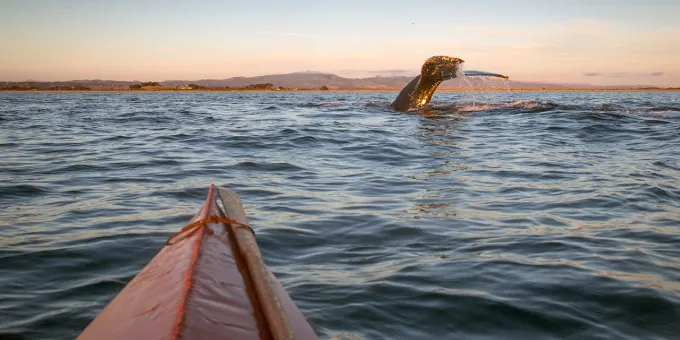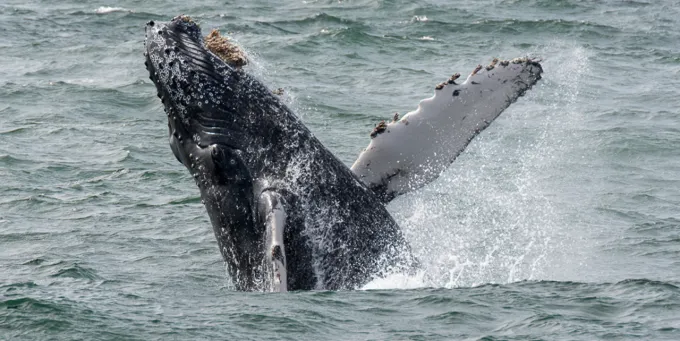California is one of the best places in the world for whale watching. Each year, about 20,000 gray whales make an epic 6,000-mile journey between Alaska and Mexico—and then back again. These massive, itinerant mammals travel from feeding grounds in the Bering Sea to mating and breeding lagoons along Baja California in Mexico, making for one of the most amazing wildlife migrations on the planet.
Here are the best places for spotting whales along the California coast, from north to south.
Mendocino
Each year, from November through April, California gray whales make their annual migration from feeding grounds in Alaska south to mate and have babies in the warm coastal lagoons of Baja, Mexico. Along the way, the whales do a swim-by off the Mendocino Coast, offering an unforgettable chance to see the leviathans spouting, breaching, and diving as they make their epic journey south. High vantage points along the coast are good spots to spot whales, particularly on calm mornings. Favorite spots near town include coastal trails in Mendocino Headlands State Park, and at Point Arena Lighthouse. For a closer look, book a spot on a Mendocino whale-watching charter, or, if you’re feeling adventurous and waters are calm, rent kayaks. (More: Mendocino Whale Watching)
San Francisco
If you want to go whale watching near San Francisco, head to the tip of Point Reyes National Seashore from December through February. According to experts, an astounding 94 percent of migrating Pacific gray whales pass within one mile of this protected peninsula some 27 miles north of the city. Other watch-from-shore locations include the headlands in Montara and Half Moon Bay (both less than 45 minutes’ drive south of San Francisco). From the city, gray whale cruises head out from Pier 39, and cruises also depart from Half Moon Bay and Santa Cruz. The Oceanic Society offers trips led by expert naturalists for a chance to see not only whales but dolphins, porpoises, and seals. (More: Whale Watching Near San Francisco)
Santa Cruz
Migratory whales, including grays, blues, and humpbacks, can all be spied off the Santa Cruz coast at different times of year, and dolphins, sea otters, and seals are observed year-round. See for yourself on exciting whale-watching cruises, chartered sailing excursions, or—for staggeringly intimate encounters—on guided kayak paddles. If you prefer to keep your feet on terra firma, take a nine-mile drive up Highway 1 to Davenport. Here, at locations like Hole in the Wall and Panther Beach, you can watch for gray and humpback whales, not to mention dolphins, blue whales, porpoises and sea lions. If you work up an appetite, drop by long-time Davenport fixture Whale City Bakery Bar & Grill for vegan treats, comfort-food classics, and local wines. (More: Santa Cruz Whale Watching)
Monterey County
Because of the cold, food-rich, and mile-deep submarine canyon just offshore, whales and marine mammals thrive here, making Monterey County an outstanding place to go whale-watching year-round. You might also sporadically spot smaller cetaceans such as fin and minke whales, as well as orcas, dolphins, and porpoises. Numerous companies offer whale-watching tours departing from Fisherman’s Wharf, or take a guided kayak tour into the open ocean off tiny Moss Landing. For prime whale watching from land, drive south along the spectacular Big Sur Coast, where high points along Highway 1 provide great whale-viewing spots. (More: Whale Watching Near Monterey)
Channel Islands
The city of Oxnard, which is less than 10 miles from Channel Islands National Park, is a perfect home base for a whale-watching excursion. Island Packers offers both winter and summer three- to three-and-a-half-hour whale-watching cruises along the Santa Barbara Channel, with the option of extending your trip to a full day to land on Anacapa or Santa Cruz Island. (The Santa Barbara Channel was designated as a Whale Heritage Site in 2023, one of only two such sites in the U.S., along with Dana Point). Channel Islands Sportfishing has tours that run from late December through April. Of the 78 species of whales, dolphins, and porpoises in the world, 29 have been spotted near the Channel Islands National Marine Sanctuary. Even if a whale doesn’t make an appearance, tourgoers can usually spy a pod of dolphins, as well as rafts of sea lions. (More: Channel Islands Whale Watching)
Los Angeles
After marveling at the model of a giant blue whale in the Aquarium of the Pacific in Long Beach, go see the real thing on Los Angeles whale-watching trips from the adjacent harbor, or head out from San Pedro to the west. When’s the best time? Just offshore, you have a good chance to spot blue whales June through October and migrating gray whales December to mid-May. Companies like Harbor Breeze Yacht Charters and Cruises and Spirit Cruises offer daily trips throughout the year. For spying whales from land, head about nine miles west of San Pedro to the Point Vicente Interpretive Center. Perched on a rocky promontory along the scenic Palos Verdes Peninsula, this site is one of Southern California’s premier locations for viewing the gray whale migration from land. (More: Whale Watching Near Los Angeles)
Orange County
Some experts believe that the 200-foot-high cliffs off Orange County’s Dana Point serve as a landmark for migrating whales. True or not, the unusually high number of whales traveling along this stretch of coast has earned it the designation of Dolphin & Whale Watching Capital of the World®, as well as recognition by the World Cetacean Alliance: it’s the first location in the Americas that the organization has named as a Whale Heritage Site. From Dana Point Harbor, Dana Wharf Sportfishing & Whale Watching offers narrated whale-watching trips all year, some aboard a 65-foot catamaran. Captain Dave’s Dolphin and Whale-Watching Safari, also out of Dana Point offers underwater viewing capability, so that you can see the marine beauties both as they jump out of the water and as they swim below the surface. From Newport Harbor and Newport Beach’s Balboa Peninsula, respectively, Newport Landing Whale Watching and Davey’s Locker offer cruises several times daily, year-round. (More: Orange County Whale Watching)
San Diego
Whether by land or by sea, San Diego is one of California’s best spots for whale watching. With just a pair of binoculars, you can catch sight of whales from the high bluffs at Torrey Pines State Natural Reserve and the Birch Aquarium, both in La Jolla, about 20 minutes north of downtown San Diego, and at Cabrillo National Monument, 10 minutes to the southwest in Point Loma. For a closer view, book a whale-watching excursion. San Diego Whale Watch and Flagship Whale Watching Cruises offer a guarantee—if you don’t see either a whale or a dolphin, you can go out again for free on another day. Other cruise operators include H&M Landing and City Cruises, which has some of the biggest and most stable in the business—a best bet for those unaccustomed to sea travel. (More: Whale Watching in San Diego)

